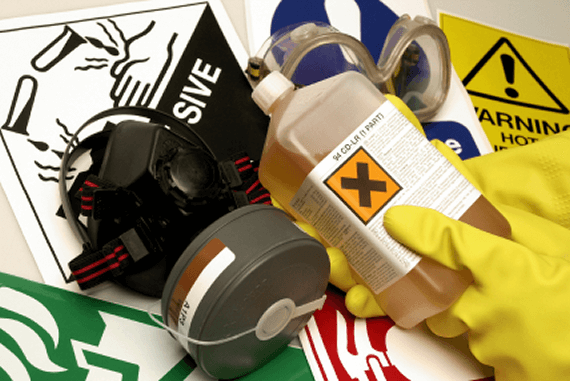- Home ››
- Health and Safety Training ›› COSHH
COSHH
What is COSHH?

COSHH stands for the Control of Substances Hazardous to Health, and is concerned primarily with the safe handling, usage and storage of chemicals and substances that pose a danger to the health of either those handling the substances or to other people.
The main intentions of COSHH regulations are to protect the health of those employees who work with and have exposure to harmful or hazardous substances. Specifically, these are substances which are described as toxic, very toxic, corrosive, harmful or irritant, as well as those that are listed as having a workplace exposure limit (WEL).
Employers are legally required to assess the COSHH risks to employees and determine the actions required to comply with legislation and regulations. COSHH regulations and legislation forces businesses and organisations to be responsible for preventing or sufficiently limiting exposure to hazardous substances. This is done either through total avoidance (e.g. keeping workers away from waste dumps), or, if the substances form an unavoidable part of a person's job, through providing the correct personal protective equipment such as gloves, breathing apparatus etc. Employers can be fined, or even imprisoned in extreme cases, for failing to provide sufficient protection or control measures.
COSHH Risk Assessments and COSHH Substances
One of the first stages in putting into place effective COSHH procedures is to perform a COSHH risk assessment, in order to identify hazards and aim to foresee potential problems. By performing a risk assessment and identifying potential problems, it allows the organisation to put into place control measures that should hopefully prevent such a problem from becoming a reality. Whilst it is impossible to foresee and predict every conceivable accident and risk, performing a COSHH risk assessment and identifying the potential problems will greatly reduce the chances of such problems occurring.
There are many substances which are hazardous to human health, ranging from minor irritants to potential killers, depending on both the type of substance and the exposure levels. The substances can be waste products produced at the end of a process, cleaning products, dust, chemical ingredients etc. The sheer number of hazardous substances in the world means that organisations in different industries will face different hazards according to the products they produce or the services they provide. For instance, a restaurant worker will handle cleaning products, but is unlikely to come into contact with construction-related substances like a builder would, which will again differ from a car mechanic dealing with hydraulic fluid, oil etc.
Different Chemicals Used in All Industries
When thinking about COSHH, chemicals and other hazardous substances, most people have a tendency to immediately think of high-risk industries which use extremely harmful substances that can cause death or serious injury in a matter of minutes. They also think that because they do not work or manage in a risky industry like this that they do not need to pay any attention to COSHH risks or COSHH regulations.
The reality is that pretty much every place of work, no matter what industry they or in or type of work that goes on, will have chemicals or other substances present that can be harmful. Even just a minor accident that results in a spillage can cause significant harm. As far as COSHH is concerned, the substance does not have to be lethal or cause horrific injuries. Even those substances that cause minor irritations are included.
This means that items such as cleaning products, substances used to maintain machinery, or by-products from the production process like dust can all come under the COSHH umbrella. Even though the majority will only cause serious harm if a person is exposed to an unusually high quantity, the fact that they can still cause some sort of harm means that your employees will benefit greatly from COSHH training.
Along with substances which can cause harm if ingested, inhaled or come into contact with a person's skin, certain COSHH substances can also create other problems. Certain types of dust can be flammable and cause explosions. Also, dust can clog air vents and intakes which can lead to machinery overheating. Both of these situations create a risk of fire, which can have potentially devastating consequences.
COSHH Prevention or Control?
If your COSHH risk assessment determines that one or more employees in your workplace will be exposed to a hazardous substance which could have a negative impact upon their health, you should first try to prevent the exposure by substituting the hazardous substance for one which is not harmful to health if this is possible. Often, working with a harmful substance will be unavoidable and an inevitable consequence of the employee's particular job role. In this case, if avoidance is not an option, suitable control measures will need to be put in place in order to protect the employee from a dangerous level of exposure. The level of exposure that is permitted will vary greatly depending upon the particular substance or substances in question. The HSE Guidance Note EH40 Workplace Exposure Limits provides a list of harmful substances that have a workplace exposure limit.
Personal Protective Equipment (PPE) and Respiratory Protective Equipment (RPE) is considered to be the final resort once all other methods of control have been assessed and deemed to be inappropriate or unsuitable.
COSHH Responsibilities
As far as COSHH is concerned, both the employer and the employee have health and safety responsibilities when working with hazardous substances. The employer is responsible for conducting suitable and sufficient COSHH risk assessments, implementing appropriate COSHH control measures, and if deemed necessary, providing the required personal protective equipment and ensuring that it is well-maintained and in good working order. They must also ensure that employees have had suitable COSHH training, and employers must supervise and monitor the use of equipment and control measures to ensure it/they are providing sufficient protection. If they are not, changes will need to be introduced.
Whilst employers need to supervise workers, it is the responsibility of the employee themselves to actually use the equipment, and in the correct way according to the safety training they should have received. Information, instruction and training should be given to all workers on the risks associated with the particular substances that they work with, the precautions that must be taken as well as the controls and equipment that must be used.
COSHH Regulations
Who Will Be Affected By COSHH Regulations?
COSHH regulations will apply to any organisation whose workers do, or have the potential to come into contact with, substances which are hazardous to health. COSHH stands for the Control of Substances Hazardous to Health and covers a broad range of different substances which can cause harm to humans such as chemicals, dust, fumes etc. COSHH regulations were put in place in order to force managers into putting effective controls in place in order to sufficiently limit, or avoid completely, their worker's exposure to hazardous substances.
The major piece of legislation relating to COSHH is the Control of Substances Hazardous to Health 2002 (as amended). This sets out the duties and responsibilities employers have for the welfare of their employees with regards to hazardous substances, including monitoring and dealing with accidents. To read the regulations on the Government's website, please click here.
What Can I Do To Comply With The COSHH Regulations?
The steps needed to comply with the COSHH regulations will differ between organisations in different industries. Each will face different COSHH risks depending on their industry, processes, level of toxicity etc.
When people think of COSHH, the immediate thought is of dirty factories with workers handling lethal chemicals. However, substances do not need to be potential killers to be covered by COSHH regulations. Minor irritants and everyday products are also covered such as cleaning products, which is why COSHH regulations affect just about every organisation in every industry.
Most COSHH controls will come in the form of either preventing workers coming into contact with harmful substances at all (e.g. keeping them away from waste), or if this is not possible, ensuring that they are adequately protected by issuing suitable gloves, face masks etc. For less harmful substances, controls may come in the form of limiting the time or amount of exposure. A COSHH risk assessment will identify the hazards where controls and monitoring are needed.
COSHH Monitoring
Once the COSHH control measures have been put in place, they need to be monitored, reviewed and amended as necessary to ensure that workers are properly protected, particularly if working practices have changed. New COSHH risk assessments will need to be performed if there is a change to the previous way the substances were used, or if different hazardous substances are being created/used, as the protection that was suitable before may no longer be adequate.
Why are COSHH Health and Safety Courses Important?
Occupational health is often not viewed with the same importance or with the need for urgency of action, often because the effects of occupational health hazards are not as immediate as occupational safety risks which can cause instant and visible harm. Also, these effects may not be as severe as a safety hazard which can cause serious injury or death, as a health hazard may just cause minor discomfort in later life.
However, these occupational health hazards can be just as dangerous and hazardous to a person's health as a hazard that poses a risk of physical injury. One of the primary and most-encompassing examples of this is COSHH; substances which are hazardous to health. These substances can come in a variety of forms including dusts, liquids, vapours, mists etc, and can enter the body primarily through inhalation, ingestion or absorption through the skin. These different forms cover so many substances that a worker in virtually every industry will encounter a COSHH risk to some extent whilst in their job role. As a result, a large number of health and safety courses cover COSHH and hazardous substances in their respective syllabus, particularly comprehensive health and safety qualifications like the NEBOSH General Certificate or the IOSH Managing Safely Certificate courses.


